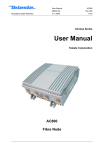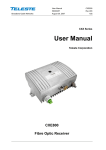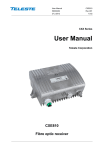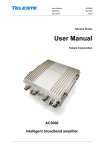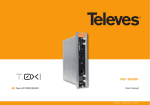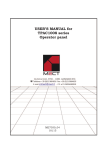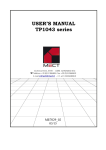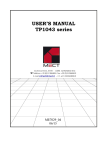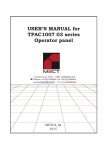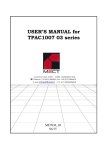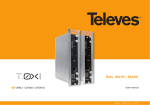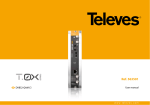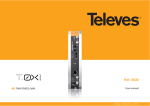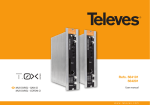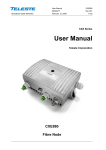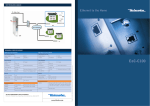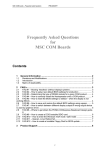Download User manual: CXE180 Universal amplifier
Transcript
User Manual CXE180 59300401 Rev.001 26.5.2010 1(12) CXE Series User Manual Teleste Corporation CXE180 Universal amplifier User Manual CXE180 59300401 Rev.001 26.5.2010 2(12) Contents Introduction ........................................................................................................ 3 Technical specifications ................................................................................... 4 Block diagram .................................................................................................... 5 Installation .......................................................................................................... 6 Housing ................................................................................................................ 6 Interfaces ............................................................................................................. 6 Powering .............................................................................................................. 7 Front panel ........................................................................................................... 8 Jumper settings ................................................................................................... 9 Adjustments ..................................................................................................... 10 Downstream signal path .................................................................................... 10 Upstream signal path ......................................................................................... 11 Legal declarations ........................................................................................... 12 User Manual CXE180 59300401 Rev.001 26.5.2010 3(12) Introduction CXE180 is a compact dual output amplifier. It has two gain modes in one product. Gain can be selected on the field according to wanted operation. Higher gain (40 dB) is designed for distribution purposes and lower gain (32 dB) is suitable for line extender use. CXE180 house distribution amplifier supports 1 GHz frequency range in the downstream and up to 85 MHz in the upstream. Adjustments use electrical controls thus eliminating the need of the usual plugin attenuators in the system set-up. Other standard features include reliable power supply, built-in US amplifier as well as an efficient surge and ESD protection. Caution! − Services and repairs should only be carried out by authorised personnel. − Do not touch live parts. − The amplifier has no separate power switch thus the power plug must be easily accessible. − The power must be cut when installing or removing the amplifier. − The amplifier must not be operated without its Standard fitted power supply unit protection cover. The lid must be closed. User Manual CXE180 59300401 Rev.001 26.5.2010 4(12) Technical specifications Downstream signal path ( all values with the diplex filters) Frequency range 47 / 54 / 70 / 85 / 108..1006 MHz Return loss 18 dB Gain 40.0 dB Input attenuator control range 0...15 dB @ 1 dB Input equaliser control range 0...20 dB @ 2 dB Cable simulator 0 / -8 dB Mid-stage slope 0 dB / 8 dB Mid-stage gain selection 40.0 dB / 32.0 dB Flatness ± 0.5 dB Noise figure 7.0 dB Output level, CTB CENELEC 42 ch 112.0 dBμV Output level, CSO CENELEC 42 ch 114.0 dBμV Output level, XMOD CENELEC 42 ch 111.0 dBμV Upstream signal path (return module and diplex filters are installed into the CXE202) Frequency range 5...30 / 42 / 50 / 65 / 85 MHzMHz Return loss 18 dB Gain 28.0 dB Gain control range (output) 0... -15 dB @ 1 dB Gain control range (input) 0 / -10 dB Slope control range 0...15 dB @ 1 dB Flatness ± 0.75 dB Noise figure 5.0 dB Output level, DIN 45004B 114.0 dBμV General Power consumption 14 W Supply voltage 26...65 V AC, 180…255 V AC Maximum current feed through 3.0 A / port Input / Output connectors PG11 (several adaptors available) Test point connectors F female (20 dB) Dimensions (h x w x d) 140 (148) mm x 182 (210) mm x 84 mm Weight 1.5 kg Operating temperature -40...+55 °C Class of enclosure IP54 EMC EN 60728-2 Additional EMC tests for RF ports ESD 4 kV / Surge 4 kV All specifications are subject to change without notice User Manual CXE180 59300401 Rev.001 26.5.2010 5(12) Block diagram Flat High gain Sloped Low gain Flat dB Cable simulation 0 dB dB -10 dB TP -20dB TP -20dB AC IN AC OUT 2 AC OUT 1 User Manual CXE180 59300401 Rev.001 26.5.2010 6(12) Installation Housing The amplifier can be installed either into a street cabinet or to outdoor environment. The amplifier should be installed in a vertical position so that the external cable connectors are underneath. At least 100 mm of free space should be left above the amplifier to ensure sufficient cooling air circulation. The class of enclosure is IP54. Note, used connector type might have lower IPclassification than the amplifier housing. The cover of the housing is closed by a single bolt. There are no hinges. Open cover is to be removed completely. When closing the cover use a PZD 2 screwdriver to tighten the bolt to a torque of 2.5...3.5 Nm. To ground the 2 amplifier housing connect at least 4 mm grounding wire (Cu) from a proper earth to the grounding point. NOTE! Make sure the input attenuator adjustment (Figure 4 pos. 5) is at its minimum level before connecting power to the amplifier. 8910044 Figure 1. CXE180 amplifier 1) Input, 2) Ground, 3) Output port 2, 4) Output port 1 Interfaces Underneath the CXE180 amplifier there are three cable connection points: input and two outputs. The amount and function of actual connectors varies with the chosen configuration. All coaxial connection points have a standard PG11 thread and they accept a KDC type adapter or connector. Available connector types are F, IEC, PG11, 5/8” and 3.5/12. 8905010 Figure 2. Centre conductor length User Manual CXE180 59300401 Rev.001 26.5.2010 7(12) Powering The supply voltage of the remote powered amplifier (26...65 V AC) can be fed through either f the output ports (Figure 1 pos. 3 & 4) or the input port (Figure 1 pos. 1). Make sure the remote powering jumpers (Figure 4 pos. 20 & 21) are in the correct positions for remote powering. Refer to chapter ‘Jumper settings’. External power can also be fed through the amplifier into the network by moving remote powering jumpers of the output ports to “on” position. Maximum feedthrough current is 3 A per port (6 A total). When F connector is used, a remote current should be lower than 2 A. Note that the external wiring connected to terminals that are hazardous live requires installation by an instructed person. Because the amplifier is not equipped with an all-pole mains switch, the powering shall be carried out in accordance with all applicable installation rules. The power intake of the remote powered amplifier may also be done externally via the cable feed-through that is located on the upper right corner of the amplifier (see Figure 3). The protective fuse is located on the left hand side of the power supply board. 8907016 AC GND FUSE Figure 3. Remote cable connector The locally powered CXE180 amplifier is connected to the main voltage of 180…255 V AC via its own power cord. The power supply is double shielded and does not require separate grounding. However, the amplifier housing has to be grounded from the grounding point. The supply voltage fuse (T3.15 A / 250 V) is located on the upper right corner of the amplifier, underneath the remote cable connector (Figure 3). User Manual CXE180 59300401 Rev.001 26.5.2010 8(12) Front panel 8910051 Figure 4. CXE180 Front panel 1) 2) 3) 4) 5) 6) 7) 8) 9) RF input Input test point, -20 dB transformer Input diplex filter Input attenuator Input equaliser Cable simulator *) Mid stage gain selection jumper *) Mid stage slope selection jumper *) Output diplex filter *) See chapter ‘Jumper settings’ 10) Output test point, -20dB directional coupler 11) Output module (see table 1) 12) RF output 1 13) RF output 2 14) Return path input attenuator *) 15) Return path equaliser 16) Return path attenuator 17) Remote powering jumper for outputs *) 18) Remote powering jumper for input *) User Manual CXE180 59300401 Rev.001 26.5.2010 9(12) Jumper settings Cable simulator jumper Mid stage gain selection jumper Mid stage slope selection jumper (Figure 4 pos. 6) (Figure 4 pos. 7) (Figure 4 pos. 8) flat high gain (40 dB) flat - 8 dB low gain (32 dB) Sloped (8 dB) Return path attenuator Remote power jumpers (Figure 4 pos. 14) (Figure 4 pos. 17, 18) 0 dB on - 10 dB off 8610040 Figure 5. Illustration of the jumper plug used for cable simulation, mid stage gain selection, mid stage slope selection and return path attenuation User Manual CXE180 59300401 Rev.001 26.5.2010 10(12) Adjustments Downstream signal path The output stage uses a GaAs hybrid to improve RF performance over the entire 47 to 1006 MHz passband. The distribution path, through the use of plugin output modules (Figure 4 pos.11), can be set up for a variety of output configurations. Refer to the ‘Table 1. Output modules with corresponding nominal attenuation values’. During amplifier adjustment the plug-in unit position for output module must be equipped at least with the 0 dB module. Set the mid stage slope of the amplifier according to the network plan calculation by means of the mid stage slope selection jumper (Figure 4 pos. 8). The available options are “flat” (0 dB) or “sloped” (8 dB). Set the output slope of the amplifier according to the network plan calculation by means of cable simulator (Figure 4 pos. 6). The output level of the amplifier is adjusted with the variable input attenuator (Figure 4 pos. 4). Measurements on the output are made at the -20 dB output test point (Figure 4 pos. 10). Make final adjustment of the output slope with the variable input equaliser (Figure 4 pos. 5). If you are having trouble obtaining the expected output level then check the input test point (Figure 4 pos. 2) to verify that the level is as expected at the input of the amplifier. The mid stage gain selection jumper (Figure 4 pos. 7) can be used to reduce gain with 8 dB if input levels are enough to cause a high distortion level in the input amplifier. The output stage uses a GaAs hybrid to improve RF performance over the entire 47 to 1006 MHz passband. The output ports, through the use of passive plug-in output modules (Fig. 4 pos. 11); can be set up for a variety of output configurations. Refer to ‘Table 1. Output modules with corresponding nominal attenuation values’. Module AC6120 AC6112 AC6116 AC6119 AC6124 AC6128 Functionality 0 dB output module, 1 output in use 1/12 dB tap, 2 outputs in use 1/16 dB tap, 2 outputs in use 1/20 dB tap, 2 outputs in use Two-way splitter, 2 outputs in use 2/9 dB tap, 2 outputs in use Output 1 0 dB -1 dB -1 dB -1 dB -4 dB -2 dB Output 2 not used -12 dB -16 dB -20 dB -4 dB -9 dB Table 1. Output modules with corresponding nominal attenuation values User Manual CXE180 59300401 Rev.001 26.5.2010 11(12) Upstream signal path Optional return path operation needs plug-in diplex filters (Figure 4 pos. 3 and 9).The available diplex filter types are CXF030 (30/47 MHz), CXF042 (42/54 MHz), CXF050 (50/70 MHz), CXF065 (65/85 MHz) and CXF085 (85/108 MHz). It is also possible to use special diplex filter of type CXF065 18 in the output diplex filter plug-in (Figure 4 pos. 9). CXF065 18 is a combined diplex filter and ingress blocker. It blocks out the lowest frequency band (5…18 MHz). If return path is not used at all, diplex filters can be replaced by forward path jumpers CXF000. The return path adjustment is based on unity gain principle such that the return path gain of the amplifier exactly matches the loss of the cable following it (i.e. cable span toward the headend). Connect measuring equipment where the return path ends (normally at the Head End, HE or at Hub). Start adjustment with the first amplifier nearest to the headend. The upstream signal path requires a specific signal level for proper operation. The ideal level at the amplifier is based on the incoming power and the maximum loss through which that signal must travel on its way to the amplifier. A typical channel level at the return path input is in range of 60…75 dBµV. Inject a test signal of known power to the output test point (Figure 4 pos. 10). The output test point can be used as an injection point for return path test signal. Measure the output level at the headend. Adjust the gain (Figure 4 pos. 16) and the slope (Figure 4 pos. 15) of the amplifier until the target level is produced. Maximum control range for the return path slope is 15 dB. The adjustment range for return path gain is 15 dB. In the case of high input level it is recommended that the return path input attenuator is in -10 dB mode. (Figure 4 pos. 14). Thus, it is possible to achieve higher attenuation with a maximum amount of 25 dB. User Manual CXE180 59300401 Rev.001 26.5.2010 12(12) Legal declarations Copyright © 2010 Teleste Corporation. All rights reserved. Teleste is a registered trademark of Teleste Corporation. Other product and service marks are property of their respective owners. This document is protected by copyright laws. Unauthorized distribution or reproduction of this document is strictly prohibited. Teleste reserves the right to make changes to any of the products described in this document without notice and all specifications are subject to change without notice. Current product specifications are stated in the latest versions of detailed product specifications. To the maximum extent permitted by applicable law, under no circumstances shall Teleste be responsible for any loss of data or income or any special, incidental, consequential or indirect damages howsoever caused. The contents of this document are provided "as is". Except as required by applicable law, no warranties of any kind, either express or implied, including, but not limited to, the implied warranties of merchantability and fitness for a particular purpose, are made in relation to the accuracy, reliability or contents of this document. Teleste reserves the right to revise this document or withdraw it at any time without notice. WEEE Notice This product complies with the relevant clauses of the European Directive 2002/96/EC on Waste Electrical and Electronic Equipment (WEEE). The unit must be recycled or discarded according to applicable local and national regulations. European Conformity This equipment conforms to all applicable regulations and directives of European Union which concern it and has gone through relevant conformity assessment procedures. Teleste Corporation P.O. Box 323 FI-20101 Turku FINLAND www.teleste.com












